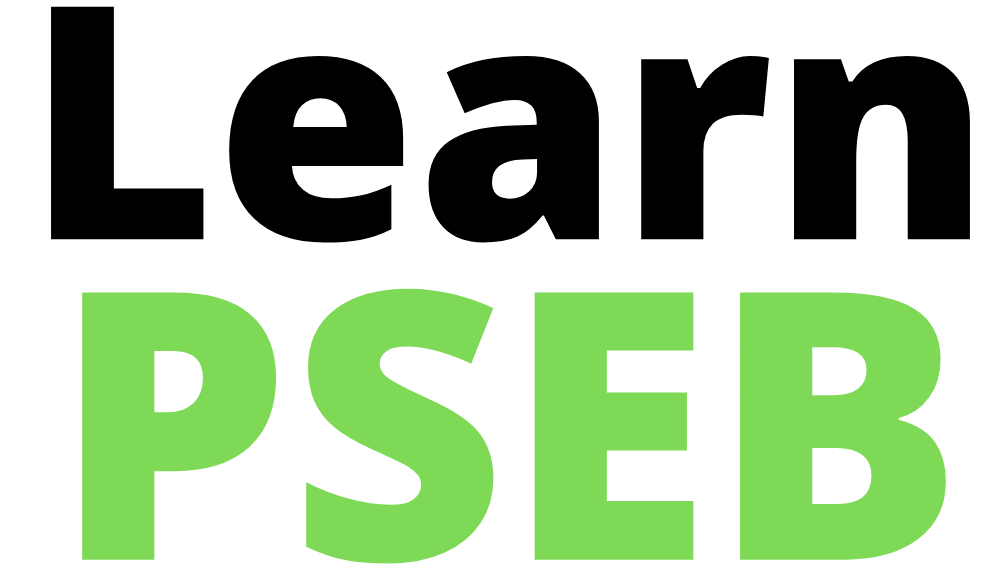PSEB Class 10 Biology Solutions For Chapter 4: Control And Coordination
Control And Coordination In Animals
In animals, control and coordination is provided by two tissues, viz. Nervous tissues and Muscular tissues.
Read And Learn More PSEB Class 10 Biology
Nervous System- It is made-up of organized network of specialized cells, called nerve cells or neurons which conduct information via electrical impulses from one part of the body to another part of the body.
Neuron- Neuron is the structural and functional unit of nervous system. It consists of three main parts, viz. Dendrites, Cell Body and Axon.
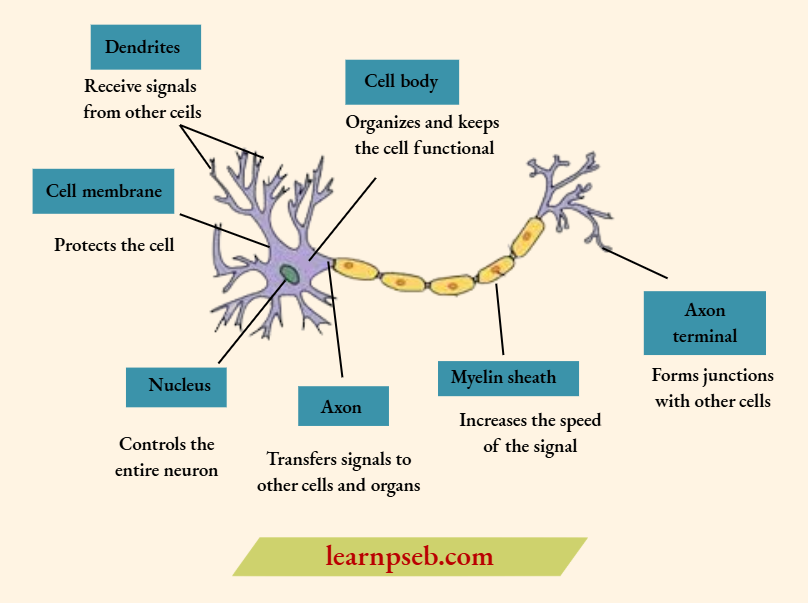
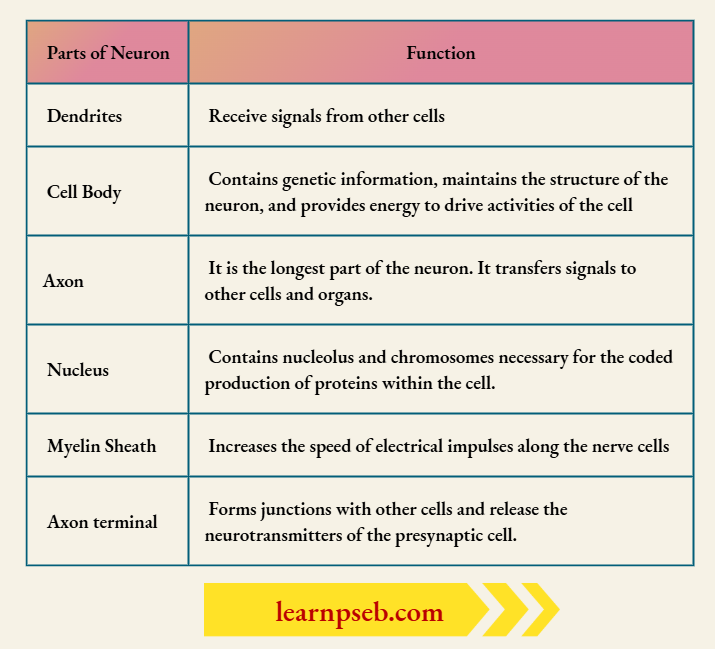
Types Of Neurons And Their Functions
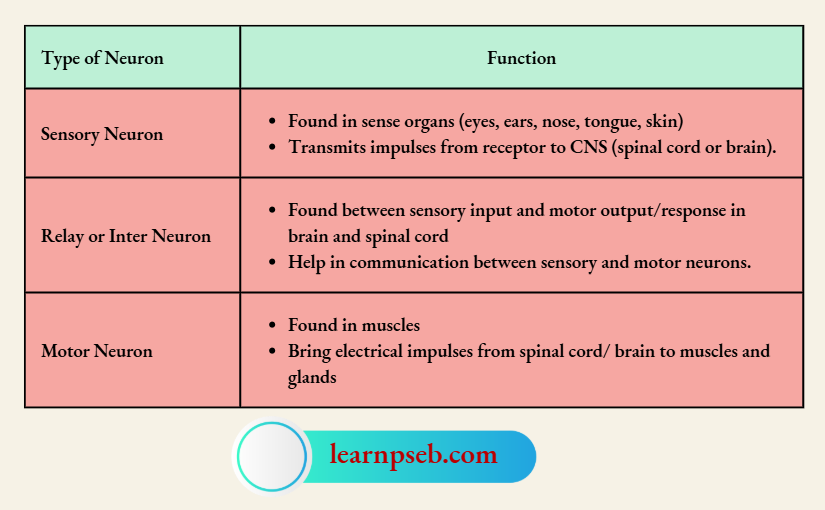
Synapse Or Neuronal Junction – It is the site of transmission of electric nerve impulses between two nerve cells (neurons) or between a neuron and a gland or muscle cell.
Pathway Of Nerve Impulse
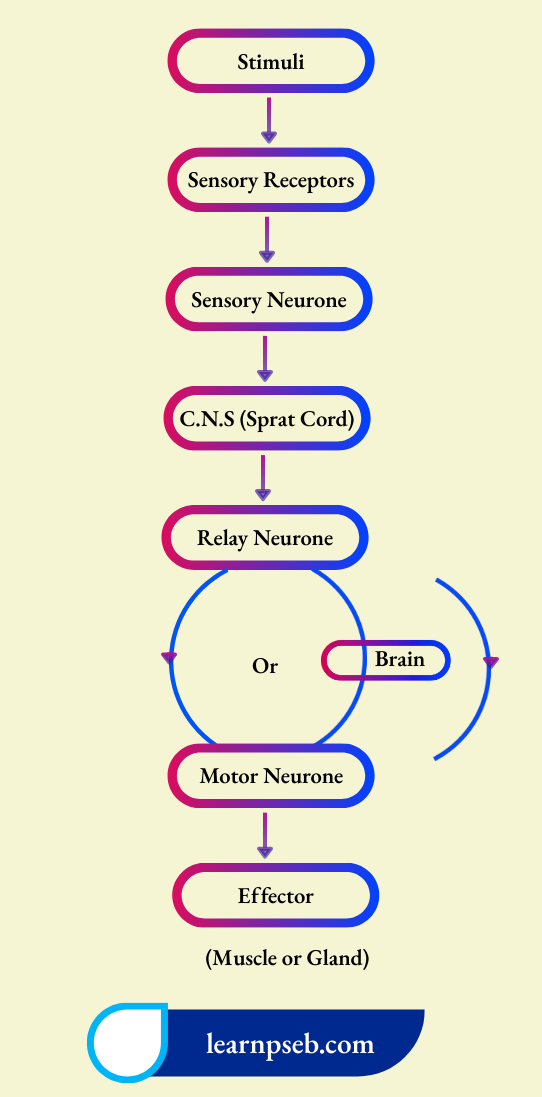
Examples of the two pathways are provided below:
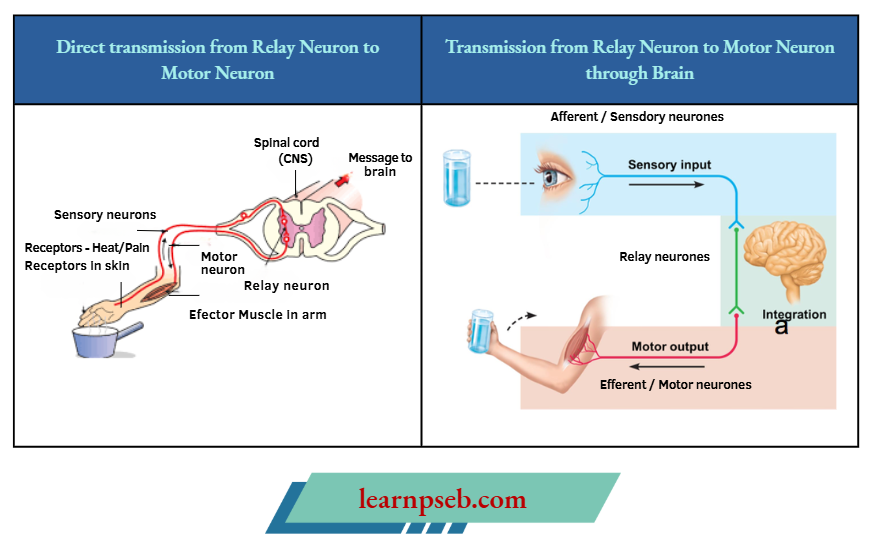
Diagram Of Synapse And Transmission Of Nerve Impulse At Synapse
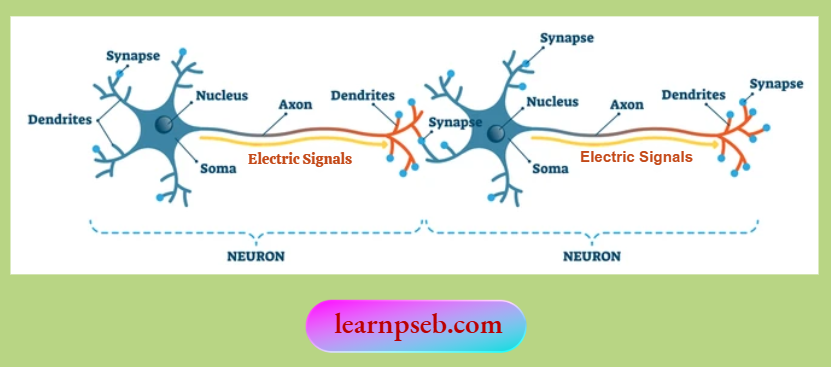
Steps involved in the transmission of nerve impulse at synapse are as follows:
- Receptors present on dendrites collect information from environment, and set off a chemical reaction that creates an electrical impulse.
- This electrical impulse travels to the cell body and then along the axon to its end.
- At the end of the axon, the electrical impulse sets off the release of some chemicals.
- These chemicals cross the gap, or synapse, and start a similar electrical impulse in a dendrite of the next neuron. In this way, nervous impulses travel in the body as shown in diagram.
- A similar synapse finally allows delivery of such impulses from neurons to muscles cells or glands at the neuromuscular junction.
Release Of Chemicals From Neuron To Muscle Cells At Neuromuscular Junction
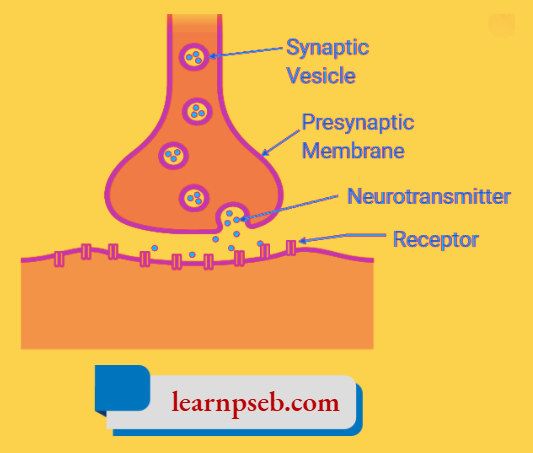
Receptors- Receptors are specialized tips of some nerve cells located in our sense organs that detect information from the environment.
Types Of Receptors, Their Location And Functions
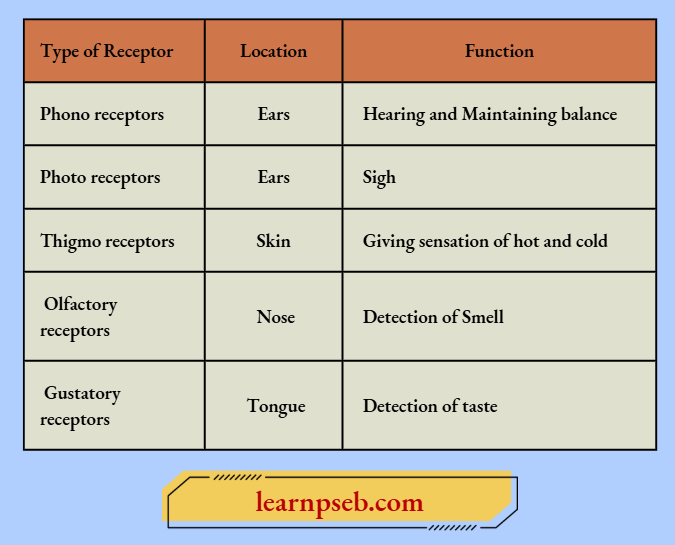
Reflex Action- A quick, sudden and immediate response of the body to a stimulus is called reflex action. Reflex actions are controlled by spinal cord and not by brain, Example
- Pulling back of hand on touching a hot object.
- Blinking of eyes when bright light is focussed on eyes is also a reflex action. This is controlled by brain. The sequence of events that occur when bright light is focussed on eyes are:
Receptor (receives message) → Sensory neuron → Brain → Motor neuron → Eye → Eye muscle contracts.
Reflex Arc- The pathway through which a nerve impulse travels during a reflex action Is called reflex arc. Nerves from all over the body meet in a bundle in the spinal cord on their way to the brain. Reflex arcs are formed in the spinal cord. Although the information is still sent to the brain, brain doesn’t have a significant response to it.
Stimulus – A stimulus is a thing or an event that evokes a specific functional reaction in an organ or tissue.
Response- The response to a stimulus can be of three main types-
- Voluntary Response- Controlled by Fore brain, e.g. running, writing, etc.
- Involuntary Response- Controlled by Mid brain and Hind brain, For Example. vomiting, heartbeat, respiration, etc.
- Reflex Action- Controlled by Spinal cord. e.g. withdrawal of hand on touching a hot object, blinking of eyes, etc.
Human Nervous System – It consists of two parts, viz. Central Nervous system (CNS) and Peripheral Nervous system (PNS).
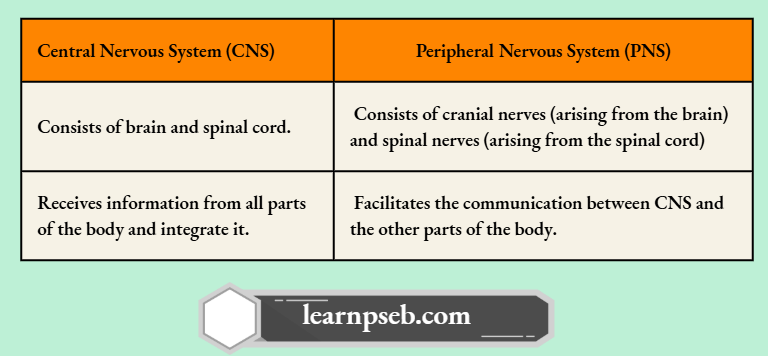
Human Brain
- Brain is the main coordinating centre of the body.
- It is contained in a bony cage (skull or cranium) which is further filled with cerebrospinal fluid for further shock absorption.
- A hard, bumpy structure at the back of the neck (vertebral column or backbone) protects the spinal cord.
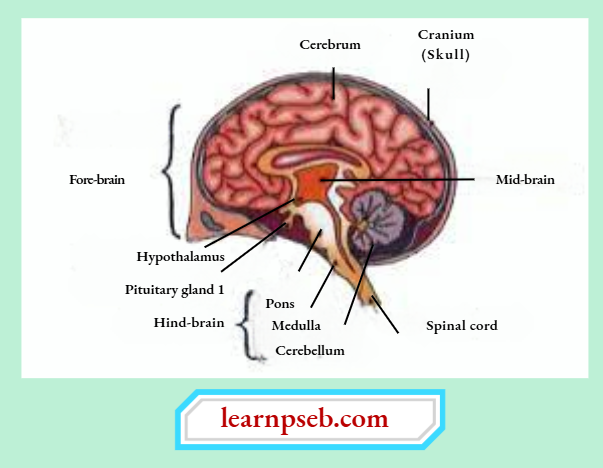
Flow Chart Of Human Nervous System And Functions Of Parts Of Brain
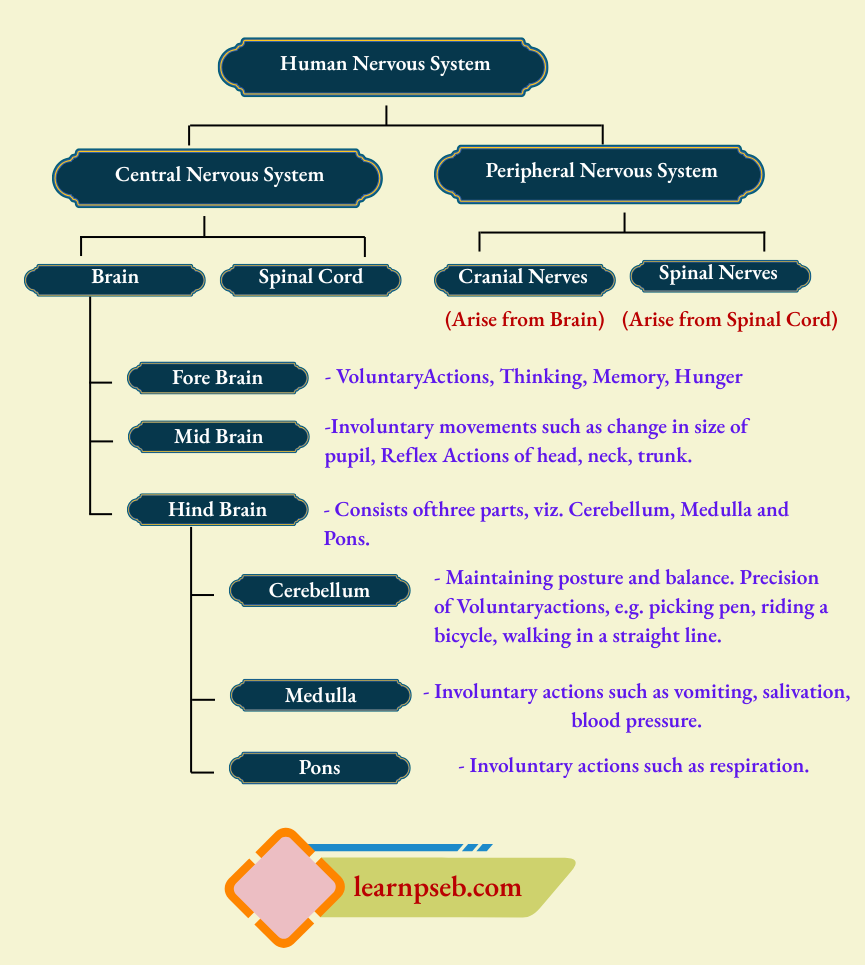
Flow Chart Of Coordination Between Nervous Tissue And Muscular Tissue
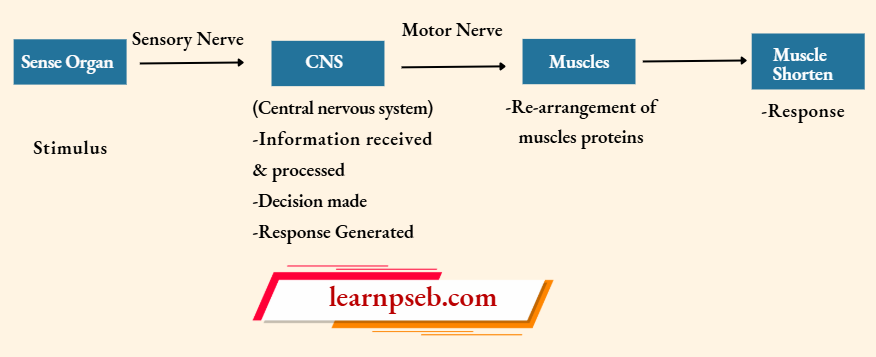
When a nerve impulse reaches the muscle, the muscle cells move by changing their shape, i.e., by shortening their length. This shortening of muscle cells occurs due to changes in chemical composition of the proteins present in the muscle cells in response to the stimulus.
Limitations Of Nervous System/ Coordination Through Electrical Impulses
- Electrical impulses will reach only those cells that are connected by nervous tissue. Since all cells in the animal body are not connected by nervous tissue, electrical impulses will not be able to reach each and every cell of the body.
- Once an electrical impulse is generated in a cell and transmitted, the cell will take some time to reset its mechanisms before it can generate and transmit a new impulse. Therefore, cells cannot continually create and transmit electrical impulses.
- Plants do not have any nervous tissue for control and coordination of their movements.
Chemical Communication In Human Beings And Plants
- In chemical communication, the cells release a chemical compound (hormone) in response to the stimulus, which diffuses all around the original cell.
- The other cells around the cells releasing the hormone have the means to detect, recognise and transmit the hormone using special molecules on their surfaces.
- In animals, chemical communication takes place through hormones secreted by various glands of the endocrine system.
- Chemical communication is a slower process.
- Advantages of chemical communication is that it can potentially reach all cells of the body, regardless of nervous connections, and it can be done steadily and persistently.
Hormones – Hormones are the chemical secretions from the endocrine glands. They are released directly into the blood. Their function is to coordinate growth and activities of the living organisms. The timings and amount of hormone released are regulated by feedback mechanisms, e.g. If the sugar levels in blood rise, it is detected by the cells of the pancreas which respond by producing more insulin. As the blood sugar level falls, insulin secretion is reduced.
Important Human Hormones And Their Functions
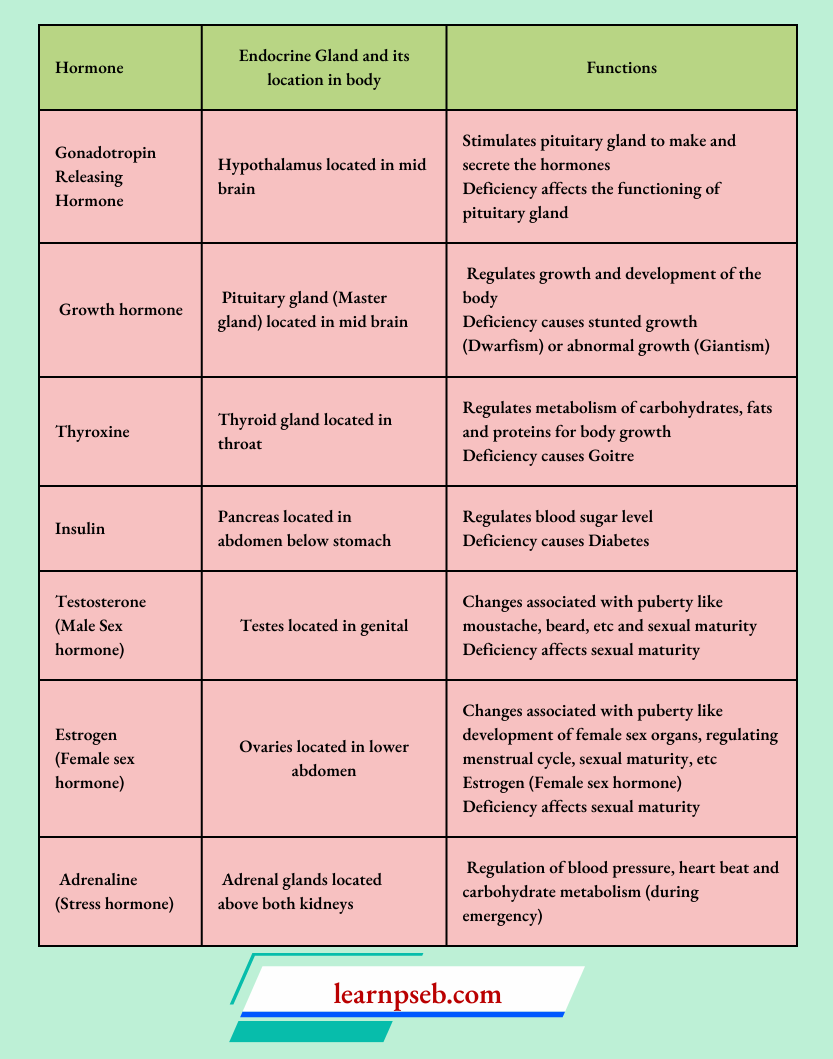
Adrenaline hormone acts on heart. In emergency situations such as fight or fear adrenaline hormone is secreted which results in faster heart beats, thus, resulting in supply of more oxygen (through blood) to our skeletal muscles. The increase in blood supply to the skeletal muscles is achieved by reducing the blood supply to the digestive system and skin by contraction of muscles around small arteries in these organs. The breathing rate also increases because of the contractions of the diaphragm and the rib muscles. All these responses together enable the animal body to be ready to deal with the emergency situation.
Flow Chart Of Human Endocrine Glands, Hormones And Their Functions
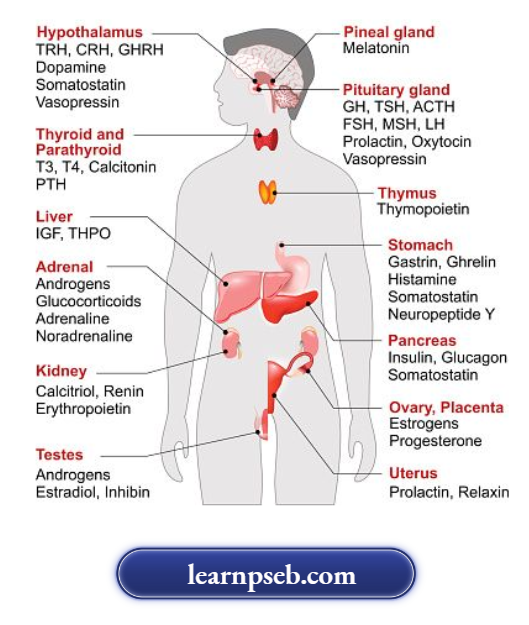
Coordination In Plants- Coordination in plants takes place through two types of movements, viz. Nastic Movements and Tropic Movements.
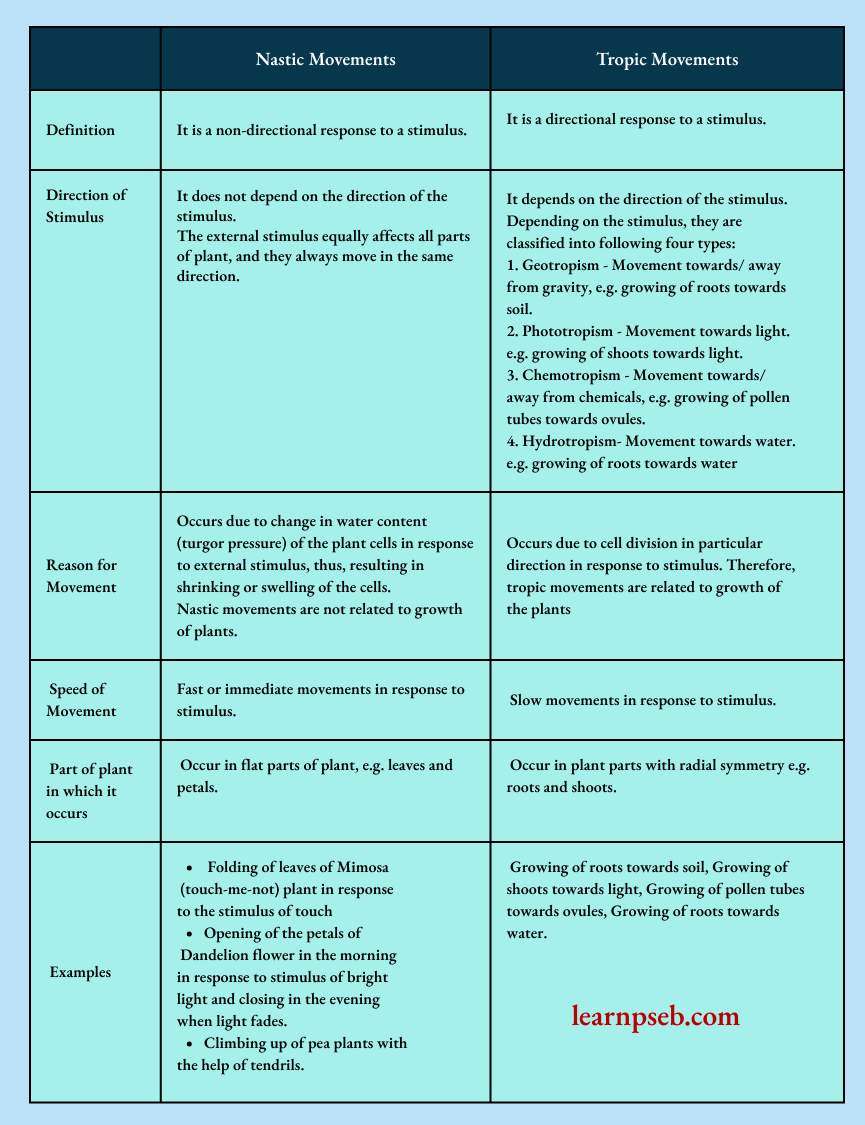
Chemical Communication In Plants- Plant Hormones
Plant Hormones Or Pheromones – These are the chemicals that help in growth, development, coordination and responses to the environmental changes in plants.
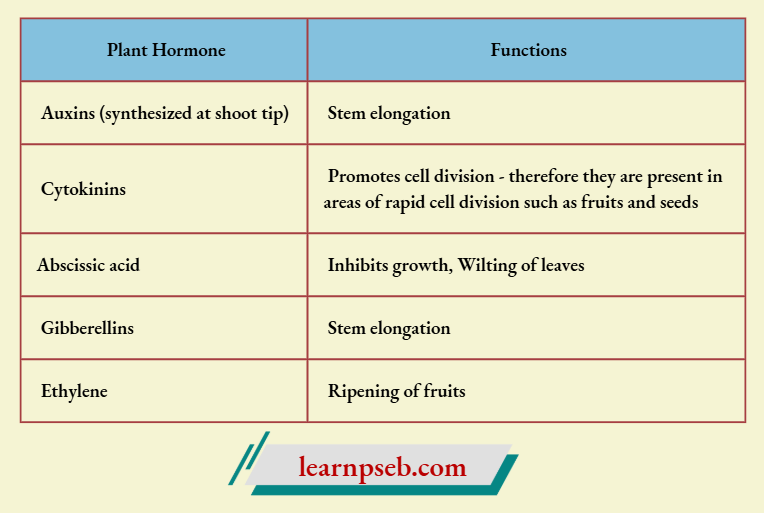
Simple Trick To Learn Plant Hormones And Their Functions
Remember the mnemonics “A CAGE” for sequence of plant hormones and “Go Come Ate Sleep Repeat” for the functions of plant hormones. Now using these two mnemonics, we can write the functions of all plant hormones as follows:
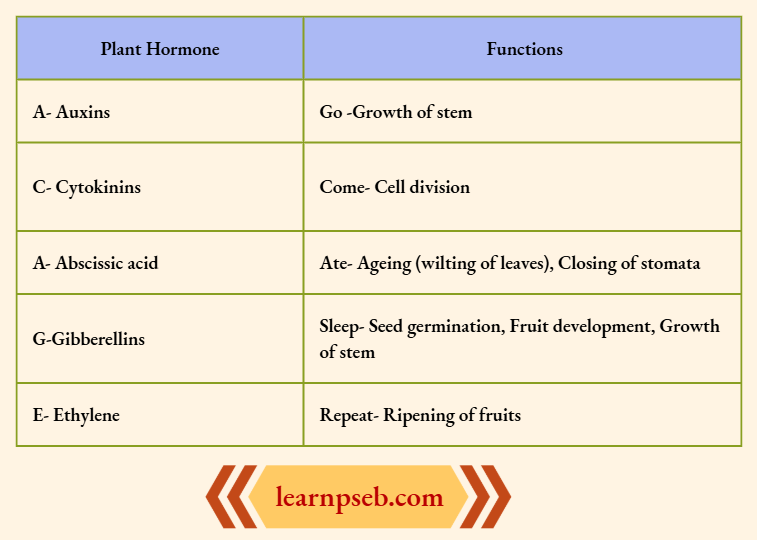
Flow Chart Of Plant Growth Promoters And Inhibitors
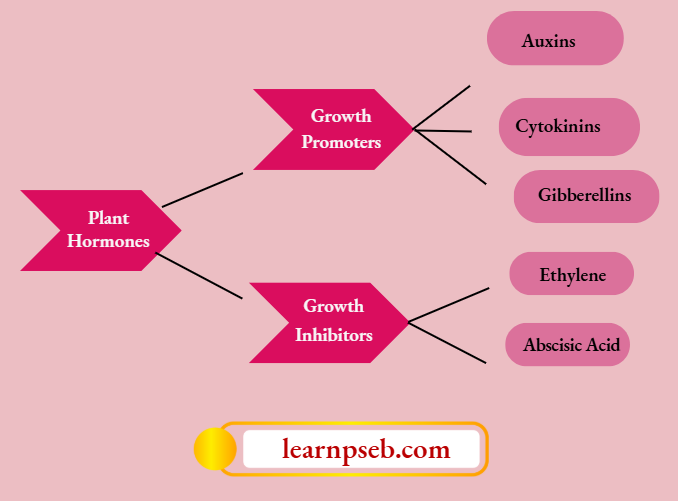
Chapter 4 Control And Coordination Case or Source Based Questions And Answers
Question 1.
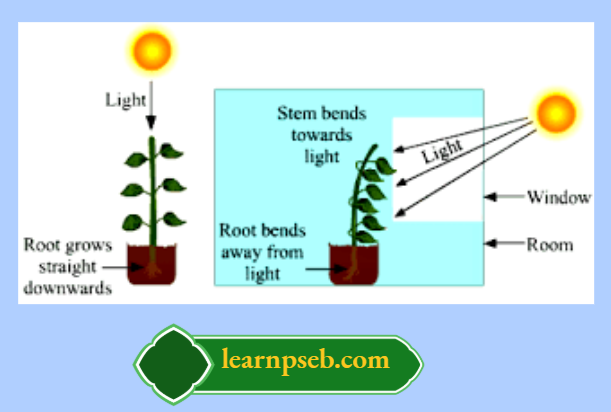
A growth movement of a plant part in response to an external stimulus in which the direction of stimulus determines the direction of response is called tropism. Thus, tropism is a directional movement of the part of a plant caused by its growth. The growth of a plant part in response to a stimulus can be towards the stimulus (in the direction of stimulus) or away from the stimulus (against the direction of stimulus) due to which we can have a positive tropism or negative tropism, respectively.
1. If the growth (or movement) of a plant part is towards the stimulus, it is called ______ tropisim.
- Positive
- Negative
Answer: 1. Positive
2. If the growth (or movement) of a plant part is away from the stimulus, then it is called ______ tropisim.
- Positive
- Negative
Answer: 2. Negative
3. The bending of the plant stem (or shoot) towards light is actually ______ phototropism.
- Positive
- Negative
Answer: 1. Positive
4. Tropism is a directional movement of the part of a plant caused by its growth.
- True
- False
Answer: 2. False
Question 2. To carry out a simple function such as eating food there has to be coordination of the eyes, hands and the mouth. The eyes have to focus on the food, the hands have to pick it up and take it to the mouth where it will be chewed. All these actions have to be coordinated in such a manner that they follow a particular sequence and the action is completed. A similar mechanism is also needed for internal functions of the body.
This function is carried out by the nervous system. It is composed of (a) Specialised cells which can detect, receive and transmit different kinds of stimuli. These are called neurons, (b) Nerve fibres which are certain bundles of extended processes of nerve cells. The individuals also have to adjust to the changing conditions around them and vary their responses. At the same time, the internal conditions of the body should be maintained constant. This is called homeostasis. The internal conditions of the body are maintained at a constant by controlling the physiology of the organisms.
1. What will the correct sequence in which conduction of information through nerves take place?
Answer: Dendrites → Cell body Axon → Nerve endings at the tip of axon → Synapse → Dendrite of next neuron
2. How homeostasis is said to maintain the equilibrium of the body?
Answer: Homeostasis helps in keeping the constant internal environment within a cell or a body and hence maintains the equilibrium of the body
3. What function does the central nervous system perform?
Answer: The central nervous system is comprised of the brain and the spinal cord which process the information received from the receptors on/in the body.
4. What happens when the dendrite tip of a nerve cell receives a signal?
Answer: Upon receiving a signal, the dendrite tip of a nerve cell sets off a chemical reaction which creates an electrical impulse in the them.
Question 3. The neural system of all animals is composed of highly specialised cells called neurons which can detect, receive and transmit different kinds of stimuli. The neural organisation is very simple in lower invertebrates. For example, in Hydra it is composed of a network of neurons. The neural system is better organised in insects, where a brain is present along with a number of ganglia and neural tissues. The vertebrates have a more developed neural system.
The human neural system is divided into two parts
- The central neural system (CNS)
- The peripheral neural system (PNS)
The CNS includes the brain and the spinal cord and is the site of information processing and control. The PNS comprises of all the nerves of the body associated with the CNS (brain and spinal cord). The nerve fibres of the PNS are of two types: Afferent fibres and Efferent fibres.
The afferent nerve fibres transmit impulses from tissues/organs to the CNS and the efferent fibres transmit regulatory impulses from the CNS to the concerned peripheral tissues/organs. The PNS is divided into two divisions called somatic neural system and autonomic neural system.
The somatic neural system relays impulses from the CNS to skeletal muscles while the autonomic neural system transmits impulses from the CNS to the involuntary organs and smooth muscles of the body. The autonomic neural system is further classified into sympathetic neural system and parasympathetic neural system. Visceral nervous system is the part of the peripheral nervous system that comprises the whole complex of nerves, fibres, ganglia, and plexuses by which impulses travel from the central nervous system to the viscera and from the viscera to the central nervous system.
1. The afferent nerve fibres transmit impulses from __________
- Tissues to the CNS
- Organs to the CNS
- CNS to tissues
- Both a and b
Answer: 4. Both a and b
2. The efferent nerve fibres transmit impulses from __________
- Tissues to the CNS
- Organs to the CNS
- CNS to tissues
- Organ to organ
Answer: 3. CNS to tissues
3. How many types of nerve fibres do PNS have? Name them.
Answer: The nerve fibres of the PNS are of two types: Afferent fibres and Efferent fibres
4. Give the divisions of peripheral nervous system and their function?
Answer: The PNS is divided into two major divisions called somatic neural system and autonomic neural system. The somatic neural system relays impulses from CNS to the skeletal muscles while ANS transmits impulses from CNS to the smooth muscles.
5. How impulses travel from the central nervous system to the viscera and from the viscera to the central nervous system?
Answer: Visceral nervous system is the part of the peripheral nervous system that comprises the whole complex of nerves, fibres, ganglia, and plexuses by which impulses travel from the central nervous systemtet/?ewsceraandfromMe viscera to the centrafnervous system.
Question 4.
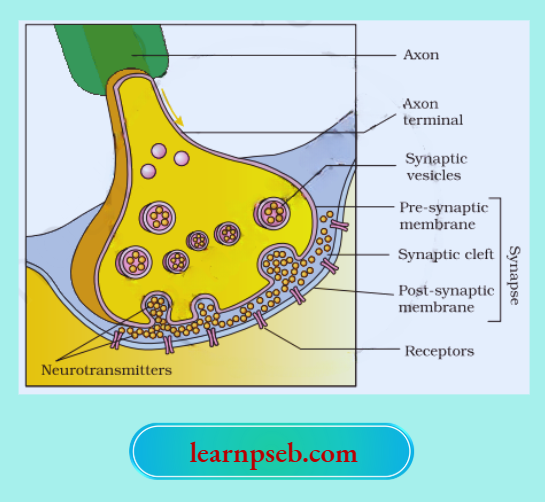
A nerve impulse is transmitted from one neuron to another through junctions called synapses. A synapse is formed by the membranes of a pre-synaptic neuron and a post-synaptic neuron, which may or may not be separated by a gap called synaptic cleft. There are two types of synapses, namely, electrical synapses and chemical synapses. At electrical synapses, the membranes of pre- and post-synaptic neurons are in very close proximity. Electrical current can flow directly from one neuron into the other across these synapses. Transmission of an impulse across electrical synapses is very similar to impulse conduction along a single axon. Impulse transmission across an electrical synapse is always faster than that across a chemical synapse. Electrical synapses are rare in our system.
At a chemical synapse, the membranes of the pre- and post-synaptic neurons are separated by a fluidfilled space called synaptic cleft. Chemicals called neurotransmitters are involved in the transmission of impulses at these synapses. The axon terminals contain vesicles filled with these neurotransmitters. When an impulse (action potential) arrives at the axon terminal, it stimulates the movement of the synaptic vesicles towards the membrane where they fuse with the plasma membrane and release their neurotransmitters in the synaptic cleft. The released neurotransmitters bind to their specific receptors, present on the post-synaptic membrane. This binding opens ion channels allowing the entry of ions which can generate a new potential in the post-synaptic neuron. The new potential developed may be either excitatory or inhibitory.
1. Impulse transmission across an electrical synapse is always
- Slower than
- Faster than
- Greater than
- Leaser than
Answer: 2. Faster than
2. Identify the incorrect statement
Statement 1- Impulse transmission across an electrical synapse is always slower.
Statement 2- A nerve impulse is transmitted from one neuron to another through junctions.
Statement 3- Electrical synapses are common in our system.
Statement 4- Chemical synaptic neurons are separated by synaptic cleft.
- Only 1
- Both 2 & 3
- Only 3
- None of the above
Answer: 1. Only 1
3. Give the name of components by which synapses is formed?
Answer: Synapse is formed of the membranes of a pre-synaptic neuron and a post-synaptic neuron, this membrane may or may not be separated by a gap called synaptic cleft,
4. Explain how neurotransmitters are released in synaptic cleft?
Answer: When an impulse comes at the axon terminal, it stimulates the movement of the synaptic vesicles towards the membrane where they fuse with the plasma membrane and release their neurotransmitters in the synaptic cleft.
5. How action potential is responsible for the formation of new potential?
Answer: When an action potential arises at the axon terminal, it stimulates the movement of the synaptic vesicles towards the membrane and release their neurotransmitters in the synaptic cleft. The released neurotransmitters bind to their specific receptors, present on the post-synaptic membrane. This binding opens ion channels allowing the entry of ions which can generate a new potential in the post-synaptic neuron. The new potential developed may be either excitatory or inhibitory.
